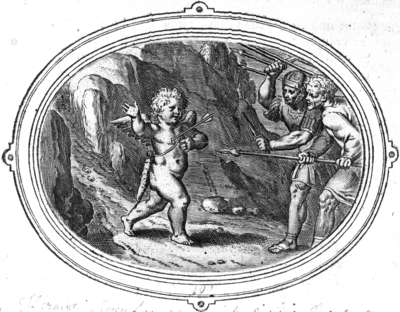Haud timet mortem, cupit ire in ipsos obvius enses [100]

Translations
 |
Seneca, Medea 593-594.
Voor de dood is de liefde niet bang en ze is bereid zich in zwaarden te storten. |
 |
Seneca, Medea 593-594.
He has no fear of death; he is eager to advance even against the sword. |
Literature
- Sebastiàn, Lectura crítica
 , p. 44
, p. 44
Sources and parallels
-
Parallel for the pictura (mirrored, less detailed) and the Latin motto (as a part of): Un Cupidon passant à travers de Déserts & retraite de Brigands (in: Daniel de la Feuille, Devises et emblemes (1691))
[Compare
![Compare [compare]](/static/images/compare2.gif) ]
]
References, across this site, to this page:
- Un Cupidon passant à travers de Déserts & retraite de Brigands (in: Daniel de la Feuille, Devises et emblemes (1691))
Iconclass
Soldiers threaten a cupid who is hit by an arrow- rocks
[25H112]

- violent death by weapon - EE - death not certain; wounded person
[31EE2346]

- hacking and thrusting weapons: sword
[45C13(SWORD)]

- helved weapons, polearms (for striking, hacking, thrusting): lance
[45C14(LANCE)]

- archer's weapons: arrow
[45C15(ARROW)]

- quiver
[45C23]

- being attacked; defence
[45H2]

- Courage, Bravery, Valiance, Manliness; 'Ardire magnanimo et generoso', 'Gagliardezza', 'Valore', 'Virtù heroica', 'Virtù dell'animo
e del corpo' (Ripa) (+ emblematical representation of concept)
[54A8(+4)]

- Danger; 'Pericolo' (Ripa) (+ emblematical representation of concept)
[54DD51(+4)]

- (personifications and symbolic representations of) Love; 'Amore (secondo Seneca)' (Ripa) (+ emblematical representation of
concept)
[56F2(+4)]

- proverbs, sayings, etc. (with TEXT)
[86(HAUD TIMET MORTEM, CUPIT IRE IN IPSOS OBVIUS ENSES)]

- suffering, misfortune of Cupid
[92D16]

- attributes of Cupid (with NAME)
[92D18(QUIVER)]

![[H O M E : Emblem Project Utrecht]](/static/images/rd-small.gif)


















































































































































